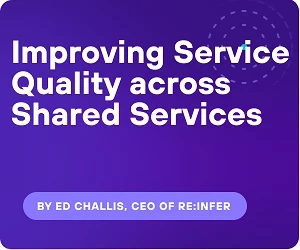What's Driving Workflow In Your Shared Services Function?
Add bookmark
In shared services - or really any services function - time and people are your most important resources. In-depth, detailed process insight and careful planning are needed to ensure your agents’ time is used most effectively. That being the case, can you say for certain what your team is working on right now? Do you know what requests are creating the most demand and driving the biggest workloads?
These questions have only gotten harder to answer as the shared services and global business services (GBS) centre has become more complex to run over the course of the pandemic. COVID-19 and the rise of hybrid working have seen service request volumes explode, new cost and efficiency targets imposed, and the emergence of a pressing need for seamless, effective customer experiences.
Service leaders increasingly depend on BPM, Process Mining, Task Mining and internal stand-ups to understand what’s going on in their services function. But this provides an incomplete picture at best. Current tools almost all share the same Achilles heel - they don’t provide visibility into service requests, the most important as well as the least efficient source of work.
The source of all workflows
Work in the shared services centre starts with communication. Almost every request and workflow begins with an email or service request. As a result, teams are spending enormous amounts of time in email, communicating with colleagues and internal customers. Indeed, the average agent sends and receives over 120 emails a day, and spends 40% of their time in Outlook alone.
There’s justification for this - communications are a precious source of insight into the running of a business. The messages an agent receives are a window into the problems plaguing employees, the causes of process breakdown, and opportunities for new services that haven’t been discovered yet. The difficulty has always been distilling down this valuable information from masses of messages and requests at the scale and speed required by the business.
However, email is also a cost centre and the leading source of service latency. Email costs businesses up to £10,000 per agent each year, but the cost rapidly increases with the size of the service workforce. Processes halt when an email is sent and only resume once it’s had a response. Service requests and support tickets are often sent to the wrong agent and must be manually triaged.
Manual email processing is a necessary task for agents to extract the information they need from email. However, it is also a highly inefficient one. Even when performed correctly, there is rarely a process whereby agents can collate and analyse all of this insight for the good of the business. The email is read, the request processed, and then the agent moves onto the next task. The shared services leader still lacks a complete overview of their service function and the work of their people.
The rise of NLP in the shared services centre
Shared services leaders are facing a mass communications problem. They have a trove of game-changing process insight right under their noses, but lack the time and resource to extract and refine it. That’s why shared services leaders are turning to natural language processing (NLP) solutions. NLP is designed to understand the complex natural language of humans, converting it into structured data that can then be actioned by the business. This makes it ideal for email and communications-based processes.
In the last few years, NLP technology has advanced to such a degree that critical business processes can now run on it. NLP can be deployed safely and reliably, helping shared services leaders understand and then streamline any email or comms-based process.
NLP is only one tool capable of driving digital transformation in shared services. However, what makes it so powerful is how it extends analysis and automation into business conversations for the first time. When working alongside RPA and other automation solutions, it’s fully capable of taking over repetitive email-based tasks and triggering the appropriate responses to inbound service requests.
This could be transformational for agent productivity. Instead of responding to routine requests on email, or forwarding a message to the right team member, they can focus on resolving complex issues deserving of their time and attention.
Efficiency gains in one area of shared services spread quickly. Not having to deal with routine email tasks means that even the most challenging request can be dealt with more quickly. Handling times fall across the board and targets are hit more quickly. Agents also win back precious time, giving them the capacity to provide new, value-adding services to the business.
Yet the biggest benefit is greater operational insight and visibility. Tools such as Process Mining can help to work out how efficient a process is, but only NLP reveals what is triggering that process. By analysing communications data through a process known as Communications Mining, NLP helps shared services leaders see what service requests are creating the most workflows and taking up the most time. This valuable insight can inform and feed into everything, from hiring decisions to more effective capacity planning.
Attempts at shared services transformation and process improvement have long been curtailed by the opaqueness and inefficiency of email and comms-based workflows. Fortunately, natural language processing is now giving them unprecedented insight and business intelligence.
Learn more about how NLP is completing the solution stack for shared services transformation.
















